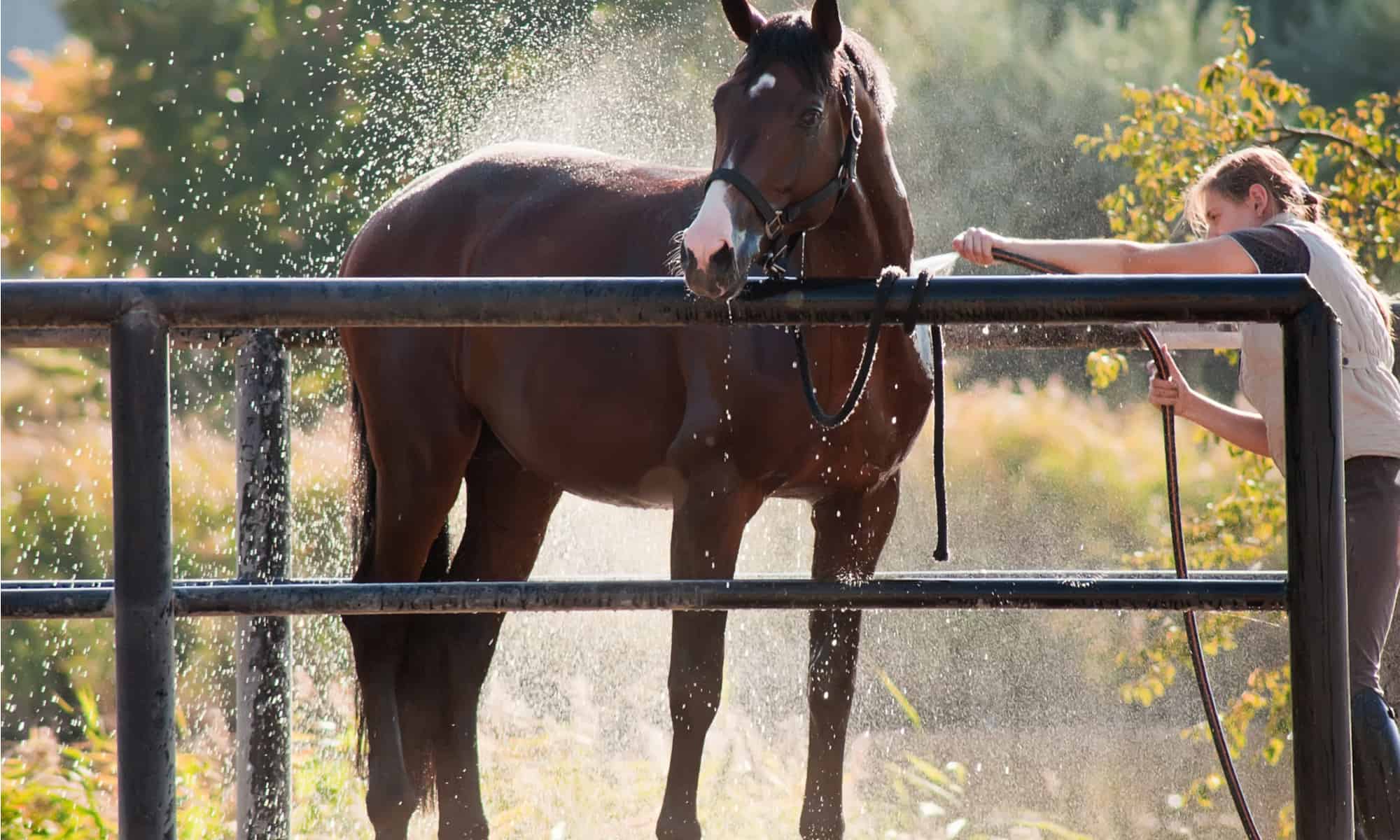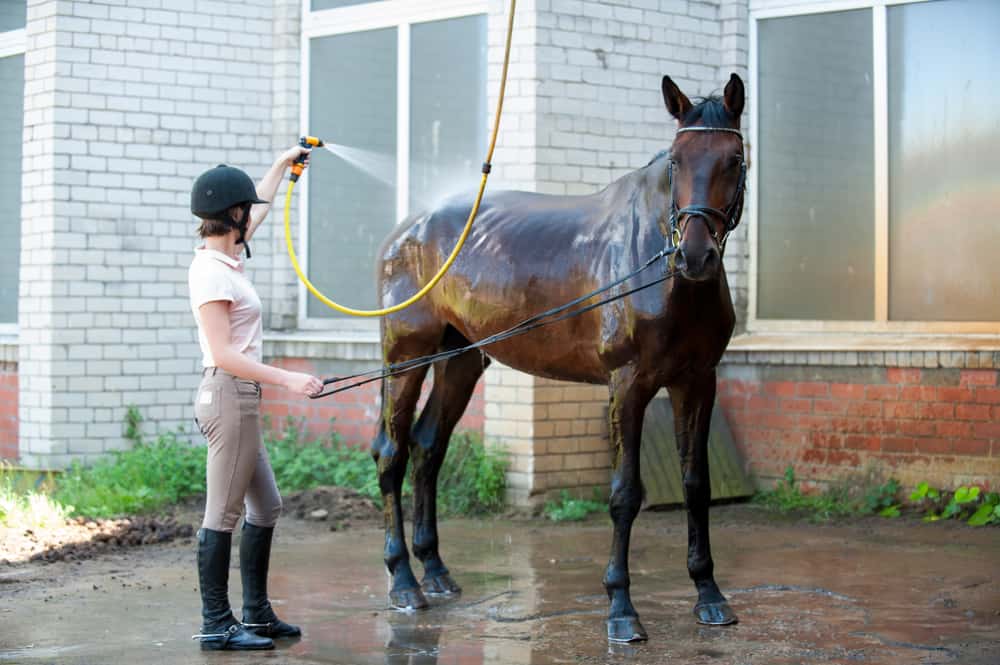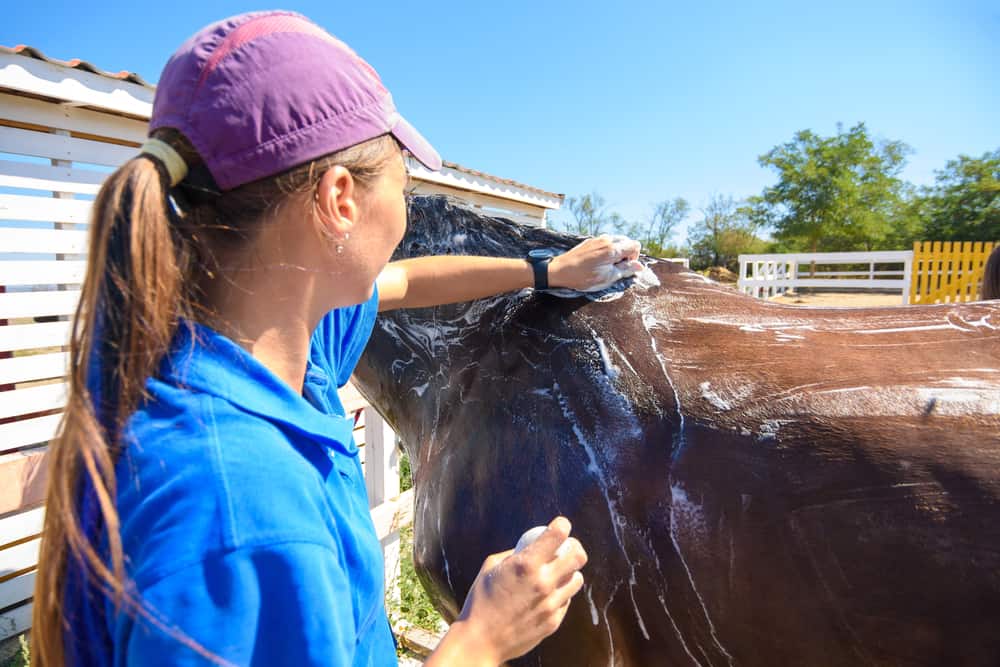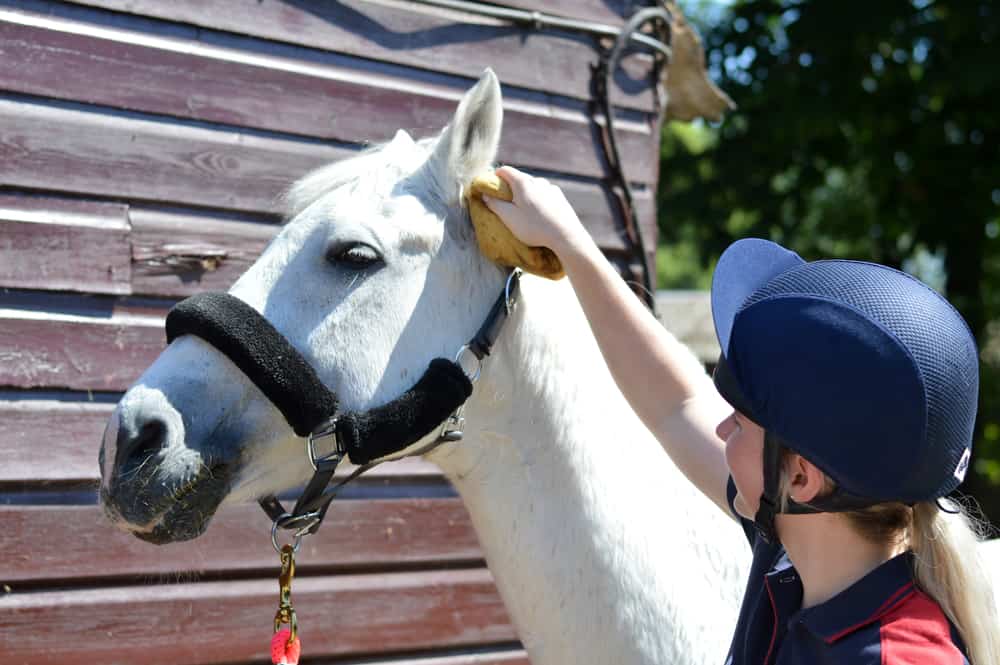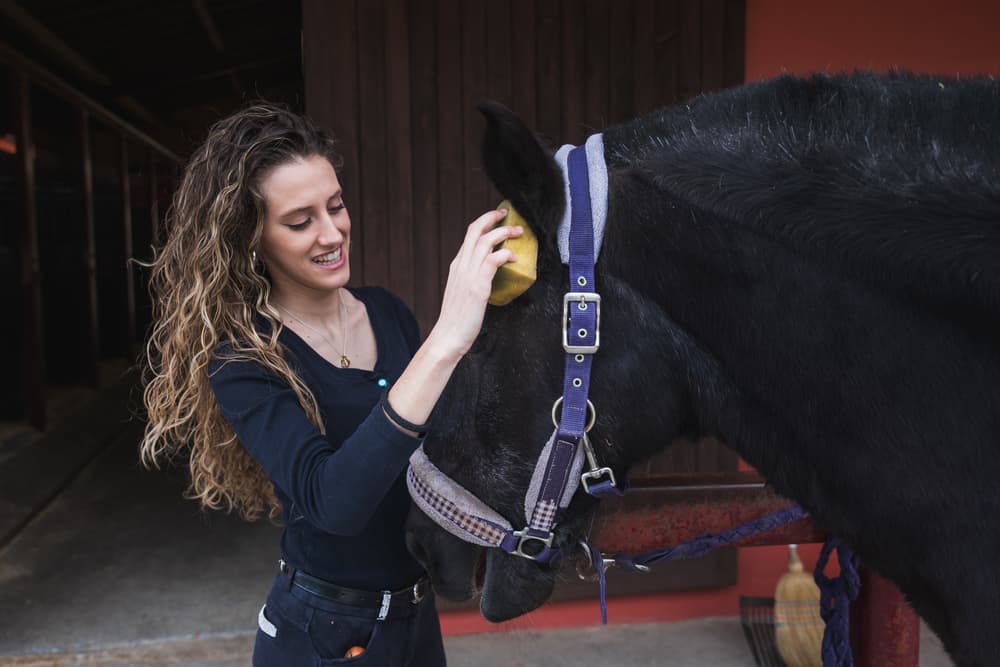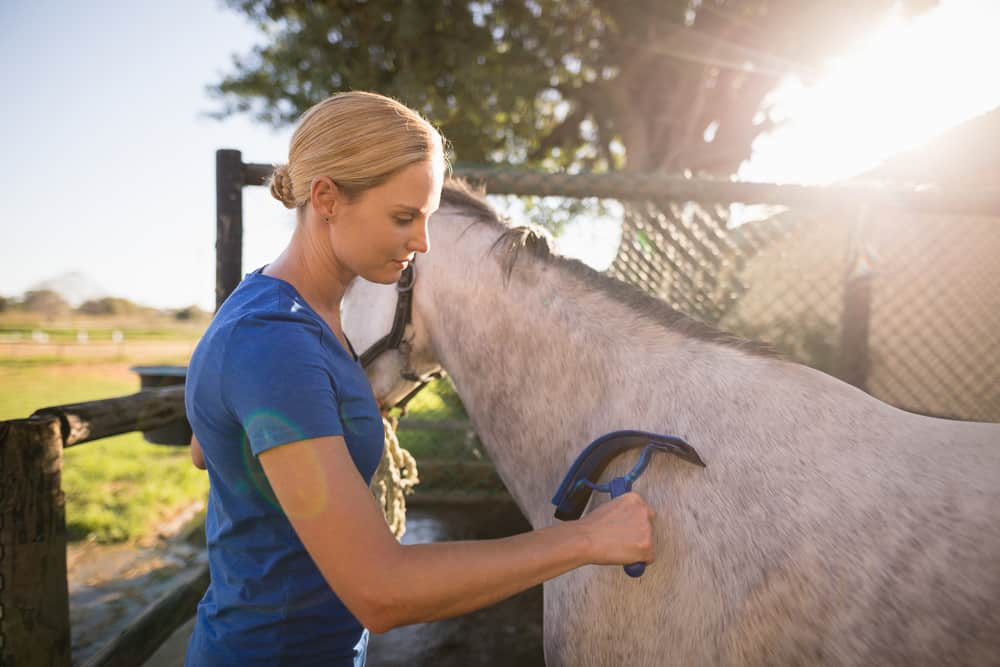If you are a proud owner of a horse, then your life is packed with several responsibilities. You have to take care of your equine friend and this entails giving it a bath. Horses are not just pack animals because they are ornamental too. Especially, if you have a Clydesdale, then you have to make sure it’s well cleaned up at all times.
So, how to wash a horse? Start by tethering your horse onto a pole. Then, soak it with enough water. Apply shampoo on the horse’s hair and scrub. Rinse away the excess soap until the horse is clean. Now, dry away the water and give your horse some warmth.
Grooming and washing your horse is the perfect time for you to bond with him. You are giving him a good surface look but at the same time a lot of attention. In this post, find out how to wash a horse.
Requirements: Items you need to wash your horse
- Shampoo
- Sweat scraper
- A Bucket (2.5 gallons)
- Warm water
- Towel
- Body sponge
- Tail detangler spray
- Twist-nozzle hose
- Scrubby mitt
- Apple cider vinegar
- Bluing rinse ( if your horse is white or grey)
- Grooming conditioner, lotion, and talc
How to Wash a Horse Step By Step
Before you bathe your horse, remember that he is sensitive to temperature changes. Ensure that it is a warm or sunny day. Chills are dangerous for your horse.
Step 1: Tie the Horse
Tie up your horse with a knot that you can swiftly untie when you require. The knot will come in hand just in case your horse gets frightened. That restricts your horse from running away.
Tip! If he gets extremely fussy, you may have to call off the exercise for a later date when he’s calm.
Step Two: Soaking
In a smooth stream, wet your horse’s body with the twist-nozzle hose. Start soaking your horse’s hooves and go up the belly and back.
Wet your horse gently so as not to scare him with the cool water. Also, do not wet his head as water may get into his eyes and make him uncomfortable.
Tip! Your horse’s genitals and anus are super sensitive too. Do not spray him with high-pressure nozzle settings.
Step Three: Shampoo
Use your hand to spread a generous amount of shampoo on your horse’s head-of hair down to the tail. Add more to the tail’s dock and gently work on the skin by rubbing in the shampoo.
Now, wash the rest of his body, including the ears, under the legs, and belly. Do not apply any shampoo on sensitive parts like the nose, ears, and genitals. Be gentle not to bring about any discomfort or pain on his skin.
Step Four: Scrub
Mix the warm water with two ounces of shampoo. Soak the face with the water while removing the excess. Get behind the ears and use the scrubby mitt to work on the hair.
Scrub the entire body, including the legs, with the sudsy warm water.
Tip! Scrub the entire body with warm soapy water before rinsing. It is easier than rinsing in parts.
Step Five: Face
Next, you want to work on his face. Though the eyes, nose, and ears are sensitive, you cannot leave the face out. It accumulates lots of dirt and sweat. Use the scrubby mitt to wash his face. You can rinse out with fresh sudsy warm water.
Rub his forelock with the suds and the hair around his eyes and ears. Watch out not to get any shampoo in his ears, nose, and eyes. The way to avoid that is to try not to trickle the sudsy water on his jaws, cheeks, and frontal face.
Step Six: Wipe Dry
Wipe his face with a damp sponge. Be keen on his ears and their backs. Take special care not to let any water into his ears to cause severe irritation and infection of the inner ears.
Hint! Horses will be more frightened by water in their ears than other parts of the head, including the mouth and eyes, so be extremely careful with the ears.
Step Seven: Rinse and Wipe
Your stallion is sparkling clean, but he needs a cool rinse. Use the hose to spray his body while leaving his face out.
Rinse his mane and all his hair, everything except the face with the hose. You can increase the nozzle pressure by twisting the nozzle so that the fur and the tail hair are free from any shampoo.
Tip! Check if the shampoo is all out by rubbing both the mane and the tail hair.
Step Eight: Warm
Your horse’s face requires a warm rinse! Fill your bucket with warm, clean water. With the body sponge, try to squeeze fresh water over his face.
Repeat until there are no suds. Rub the face gently with your hands to spot any suds; if there are, repeat the exercise until the face is free from shampoo.
Step Nine: Polishing
Once there are no shampoo residues left, your horse is ready for the bluing rinse (if he is grey or white). Use the bluing rinse, and be sure to apply it all over his hair.
Tip! Consider combining the bluing rinse with diluted apple cider vinegar for a glossy, shiny coat. The vinegar also keeps bugs off.
Step Ten:
Time to dry up your horse! No drip-drying! Use the sweat scraper to drain water off the body. Begin with his back and down to his knees, then the hocks. Scrape following the air direction and hasten the process to prevent your buddy from chills. Use a clean sponge to dry is skin thoroughly.
Step Eleven
Master Stallion is ready for a grooming treat. Apply a luxurious lotion or conditioner on his hair, including the mane and the tail hair. Massage him gently and spray the hair detangler spray. Work on the hair with your hands to detangle any knots, and proceed to comb him gently.
Finally, if it is sunny or warm, take your horse for a brief walk to get his circulation back to normal. If the weather is windy or cold, cover him with a breathable bed warmer or blanket.
How to Clean a Horse Without Water
Like humans, horses’ hair grows thick and extended during the cold weather. Dirt and sweat get trapped in their coats. You will find it too smelly to wait until summer so that you can give your buddy a perfect scrub. It remains a tug of war between bathing and not bathing your horse.
Try out these alternatives:
- Vacuuming: With a currycomb, loosen the dirt particles from his coat. Use a vacuum to puff all the dirt away from the skin.
- Hot Toweling: Use a brush puff off dirty particles off the coat. Apply a mild cleaning product on any visible stains or the whole body. Rub in the solution and damp a clean towel in warm water. Wring out and then wipe the coat repeatedly until your horse is clean
- Scrapping: You can opt to scrape off the mud from your horse body and wait until it’s warm and sunny enough to go for a bathing spree.
TIPS of Washing a Horse
- Never bathe your horse in cold and windy weather.
- Your horsetail carries a ton of dirt. Deep it in warm water with enough shampoo to remove all the dirt particles.
- Detangle your horse’s mane and tail hair with your hands, spray in a unique horse detangler for easy combing.
- Drain water from your horse’s coat using a sweat scraper, and be sure to follow the direction of the hair.
- Assemble all the requirements before you begin the bathing exercise.
- If your horse is not willing to take a bath, do not force. Postpone the exercise.
FAQs
How regularly should you bathe the horse?
Your horse does not require a bathe like humans. If you are worried about the hot summers, you can bathe the horse but not all the time.
During the hot weather or strenuous activity like racing, you can treat your horse with a cool bath to relieve his muscles. You will also get rid of stubborn stains with a warm bath.
If you have got an even, you want your stallion to look bright and glossy. Before you take your bath, treat your buddy to one that will ensure that his shiny coat wins the contest.
Should you bathe horses in the winter?
Horses shouldn’t get baths in the winter. In winter, their bodies react to temperature changes. During winter, it will be difficult for the horse to maintain its body temperature.
Low temperatures lead to a sudden drop, which is dangerous to your horse. Sadly, a sudden decline in temperatures can cause severe illnesses or even fatalities.
However, you can use the waterless cleaning methods such as those in this video:
Can you wash a horse with cold water?
You cannot wash your horse in cold water or weather. You need to note that horses are sensitive to temperature changes. Like humans, they can get chills and cold. That can leave you on the run helter-skelter for a veterinarian. Never wash your horse in chilly or winter weather.
How can I dry the horse’s tail and mane?
Drying your horse’s coat, especially the tail and the mane, can pose a challenge to you. That is if you have no patience. You require to use a sweat scraper to perform this task perfectly. Start from the neck and scrape towards the direction of the hair growth.
Scrapping will remove all the excess water from your horse’s body. Use a dry sponge and towel to absorb extra water from the head, ears, and hair. Head on to the tail while changing towels, as they get damp.
Apply a detangler and use your hands to comb through the mane and the tail. When the hair is all detangles, use a clean comb to work on the hair. Leave the air dry as you walk your buddy around.
How should you wash a horse’s head?
The trickiest part to wash in a horse is the head. The rest of the body is spray, lather, scrub, and rinse, but your horse’s head has the most sensitive organs.
A drop in the ear may leave your stallion running for safety! Contrary to your thoughts, the organ is more sensitive than the eyes and the nose.
When bathing your horse, the head should be the last. Dip a sponge in clean, warm water and wring it out. Step on a stool to reach the entire face.
Scrub behind the ears avoiding the inner parts and the eyes. If the head is highly filthy, use a mitt to scrub the extra dirt. Rinse his face with a clean cloth or sponge.
Dip the sponge in clean, warm water and wring it out to remove excess water. Wipe the entire head repeatedly clean to ensure that you wipe all shampoo residues.
